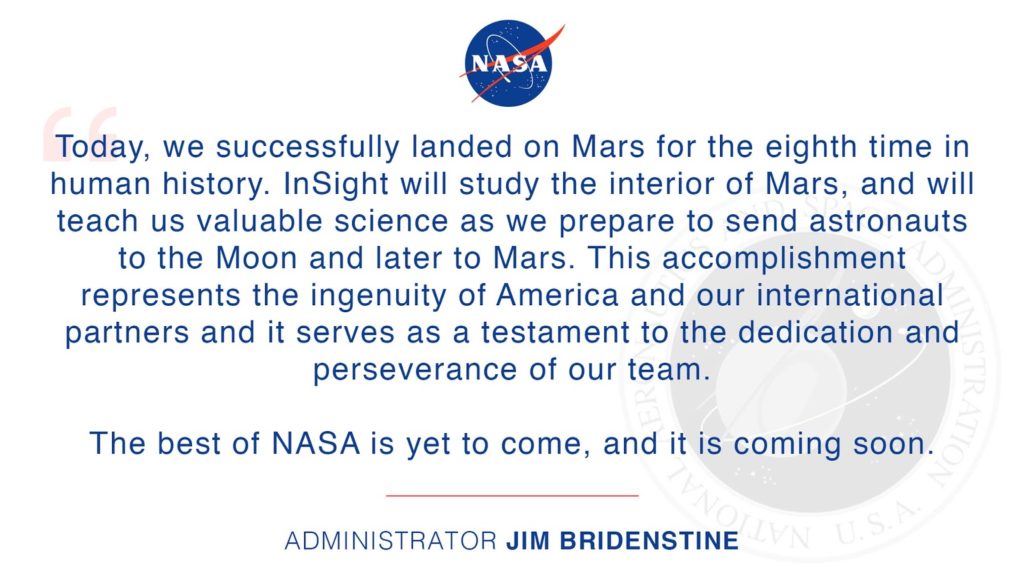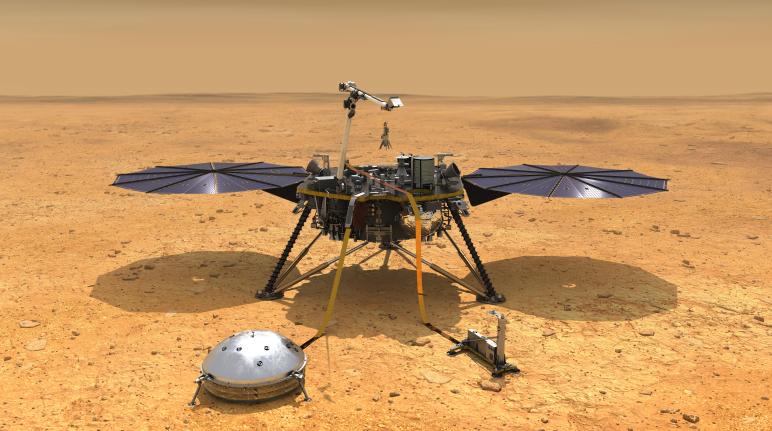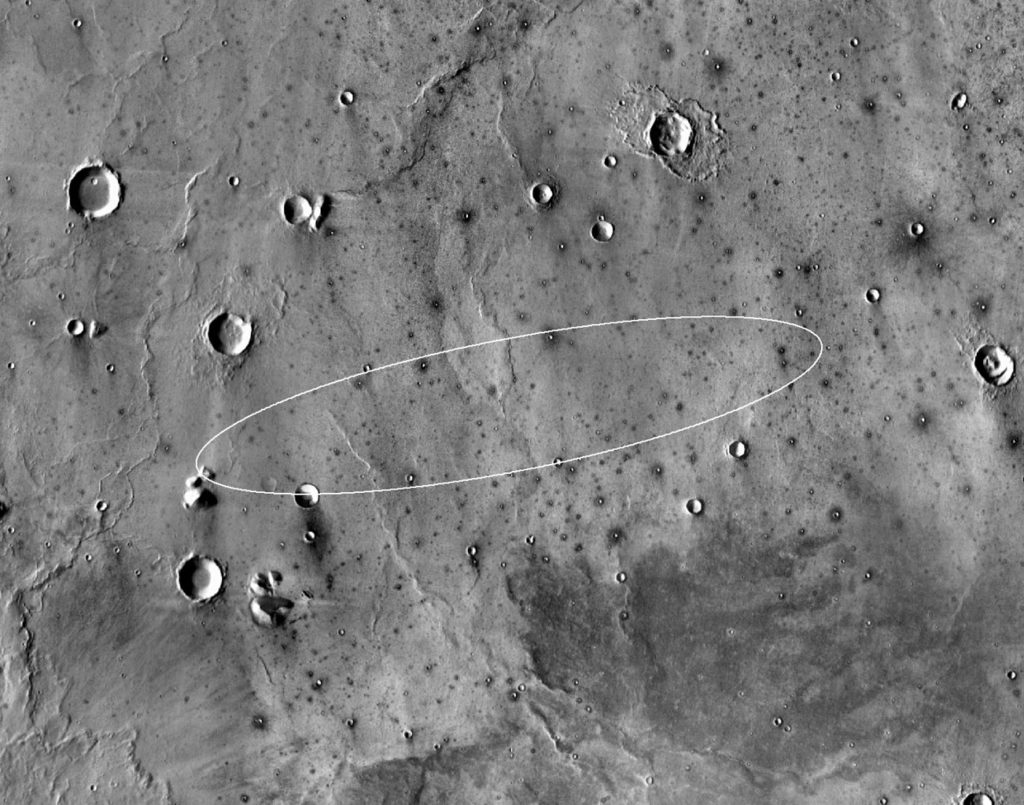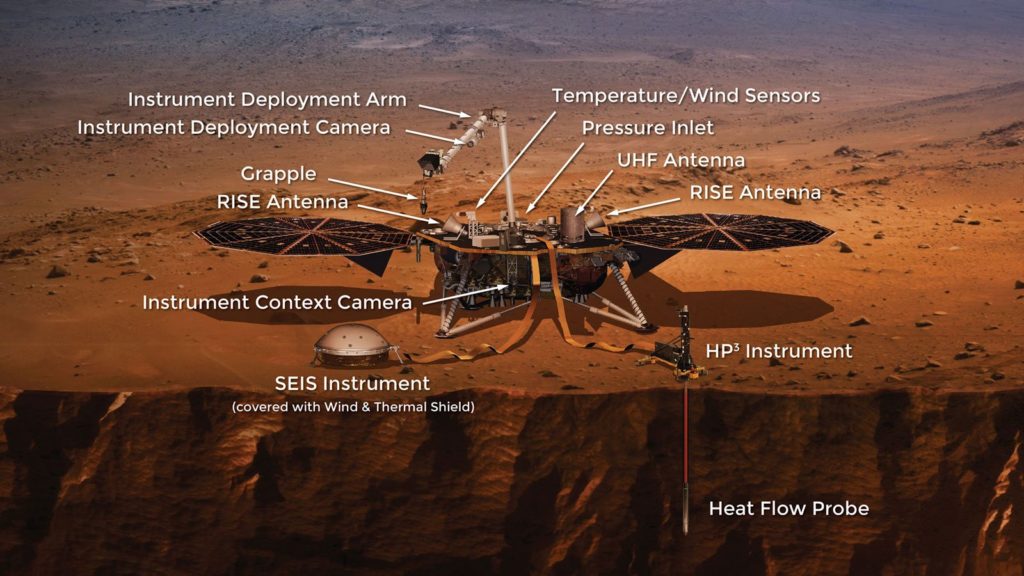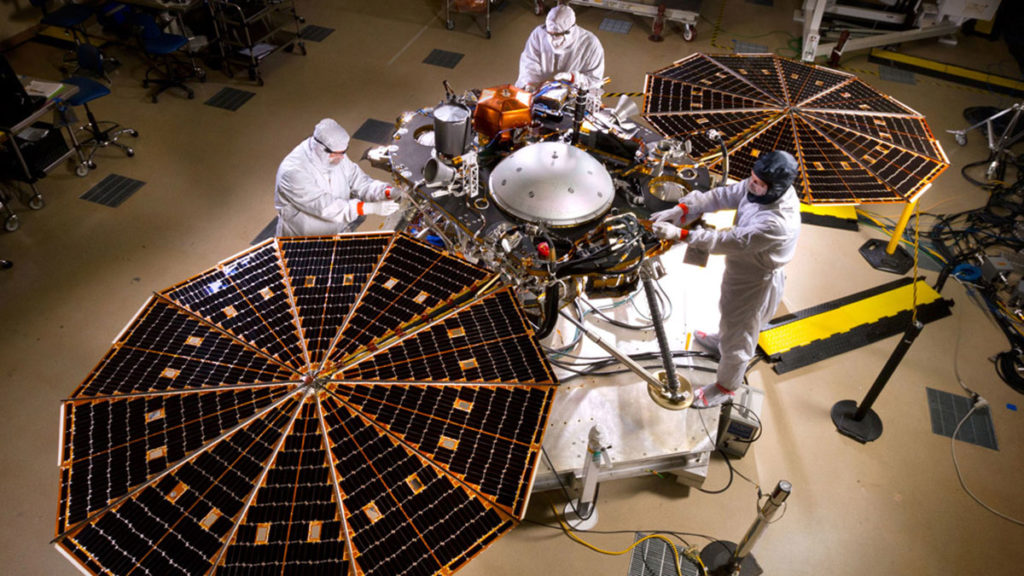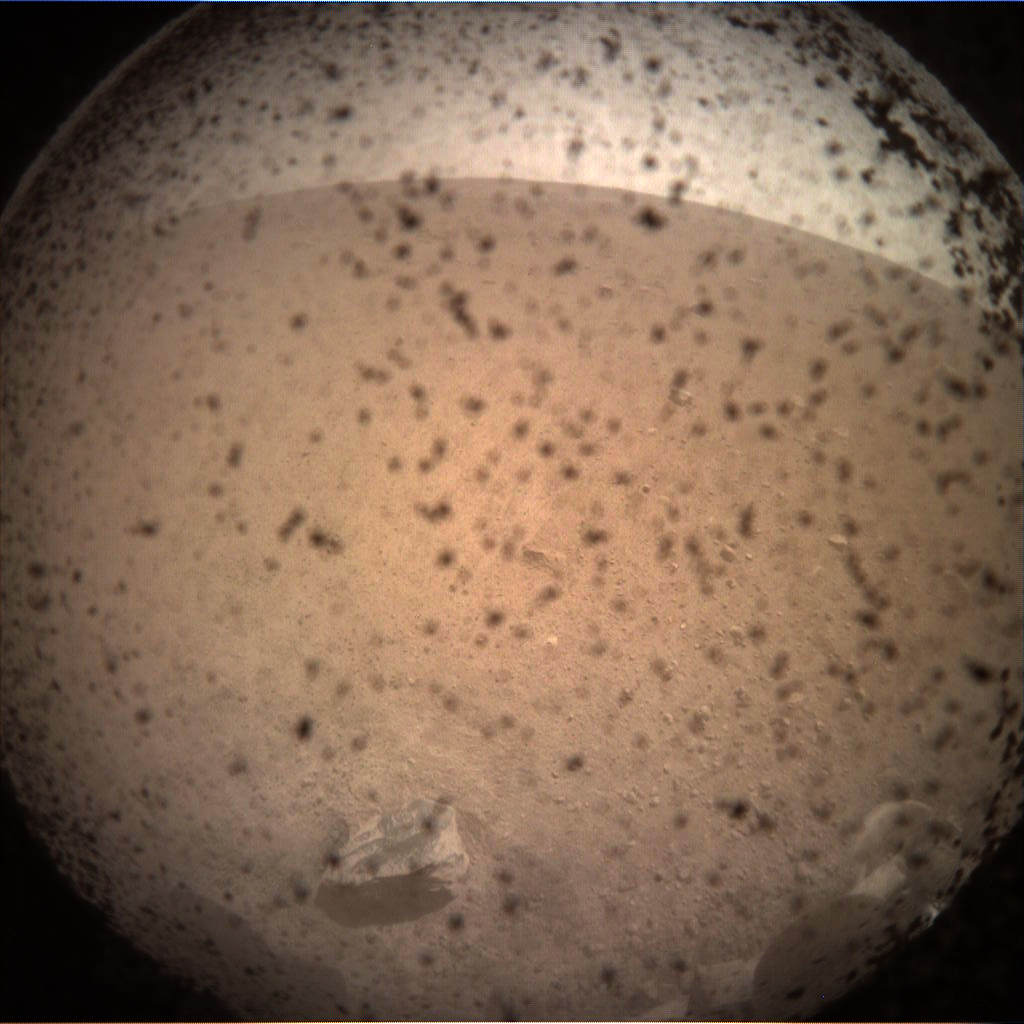 |
| @NASAInSight sent home its first photo after #MarsLanding on Nov. 26, 2018: InSight’s view is a flat, smooth expanse called Elysium Planitia, but its workspace is below the surface, where it will study Mars’ deep interior. |
Ken
Kremer —SpaceUpClose.com & RocketSTEM –26
November 2018
CAPE CANAVERAL,
FL – Congratulations InSight !!! NASA’s newest Mars mission the Insight Lander sticks flawless Mars landing just moments ago at 2:54
p.m. EDT, 11:54 a.m. PST, following a 7
month, 301 million mile (484 million km) interplanetary journey from Earth – and now starts a 2-year mission to explore the Red
Planet’s mysterious deep interior.
“Touchdown confirmed,”
reported Christine Szalia of mission control at NASA’s Jet Propulsion
Laboratory, Pasadena, CA, live on NASA TV webcast.
“InSight is on the
surface of Mars!!”
Louds cheering and
boisterous applause erupted immediately at JPL, throughout NASA and worldwide
at the fantastic success and reality of InSight becoming NASA’s 8th mission to successfully touchdown
on Mars.
“This is really
fabulous,” said JPL’s chief engineer Rob Manning offering commentary on the webcast. He has worked on all of NASA’s Mars landers and
rovers for more than 20 years going back to Mars Pathfinder in the 1990s.
“Flawless!Everything
we hoped for!”
Now resting safely on
the surface of the Red Planet, InSight
can now begin at an alien locale called ‘Elysium Planitia’ InSight can now move forward to start her studies of the heart of Mars
and its deep interior for the first time in human history.
InSight is the first
mission to drill down deep below the surface and explore Mars deep interior. All prior missions have scratched the surface
of the fourth rock from the Sun by design for rock and soli samples. Now we go
deep !! – to listen for Marsquakes and measure heat flow emanating from far below!
“It was intense. And you could feel the emotion,”
said NASA Administrator Jim Bridenstine, at the JPL briefing.
“It was very, very quiet when it was time to be quiet
and of course very celebratory with every little new piece of information that
was received. It’s very different being here than watching it on TV, by far, I
can tell you that for sure now that I’ve experienced both.”
InSight survived all the treachery and blazing
temperatures of the ‘7 Minutes of Terror’!!
The $830 million spacecraft slammed into the top of Martian
atmosphere at over 12,300 miles per hour (5.5
kilometers per second, 19,800 kph) and approximately 80 miles (about
128 kilometers) altitude at around 2:47 p.m. EST, 11:47 a.m. PST and experienced blazes temperatures
reaching up to 2700 degrees F (1500 C) – enough to melt steel – while protected
from melting and utter destruction by the advanced heat shield.
“We spend
most of our time visualizing all these bad things that can happen, but
sometimes things work out in your favor,” said Manning. “It certainly looked like it was a very
successful and perfect landing.”
Ultimately InSight used a preprogrammed series
of maneuvers and operated autonomously throughout all of EDL EDL (Entry, Descent and Landing) with the heat shield, a
supersonic parachute and 12 landing thrusters in succession to slow her descent to about 5 MPH
(8 kph) at touchdown – brilliantly concluding the harrowing ‘7 Minutes of
Terror’ at approximately 2:54 p.m. EDT, 11:54 a.m. PST.
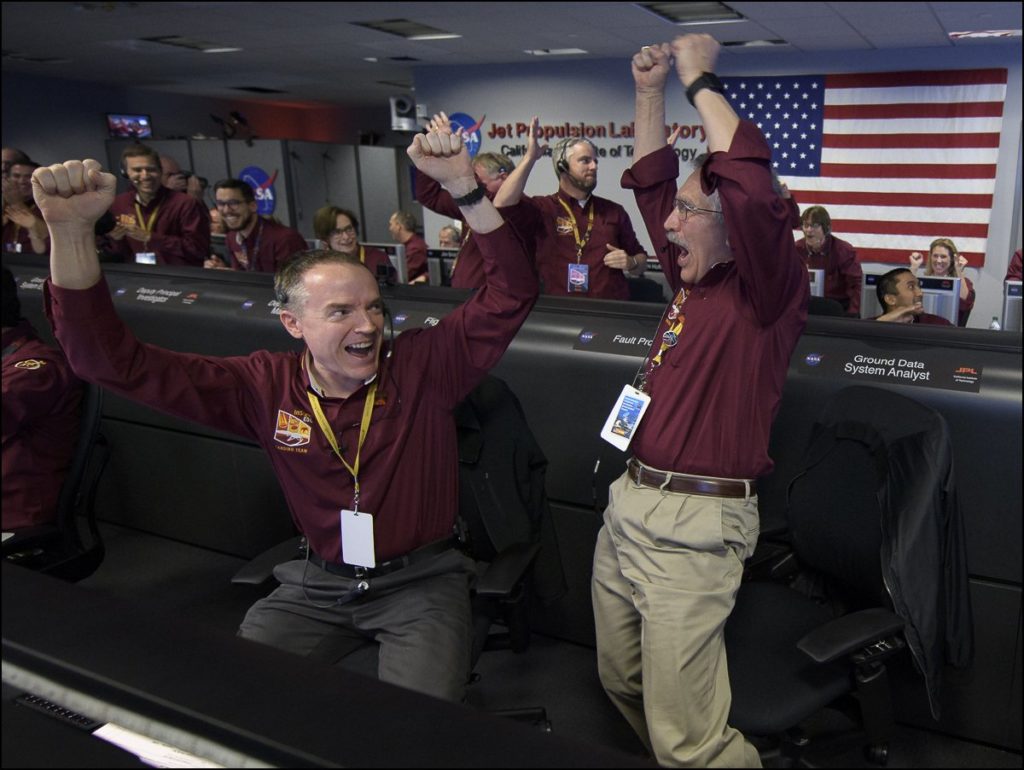 |
|
@NASAInSight
team members rejoice @NASAJPL after getting confirmation of a successful landing on Mars. #MarsLanding Images: https://flic.kr/s/aHskMTrajC |
later NASA’s InSight transmitted her first post touchdown photo from the
surface of the Red Planet at the landing site named Elysium Planitia – a sandy, flat plain with few rocks and chosen because it
offered the best chances for a successful landing and science gathering.
The fisheye camera is
covered by a dust cover accounting for the dusty image – that will soon be
released to provide a crystal clear view of the landing site.
“Our @NASAInSight spacecraft stuck the #MarsLanding!”
“Its new home is
Elysium Planitia, a still, flat region where it’s set to study seismic waves
and heat deep below the surface of the Red Planet for a planned two-year
mission,” NASA tweeted along with the 1st photo.
“Congratulations to @NASA, @LockheedMartin, @ulalaunch, & all who made today’s @NASAInSight #MarsLanding possible! This marks the 8th time the US has landed on
Mars & the 1st mission to study its deep interior. Incredible milestone!”
tweeted VP Mike Pence who called the team with congratulations seconds after
the successful landing.
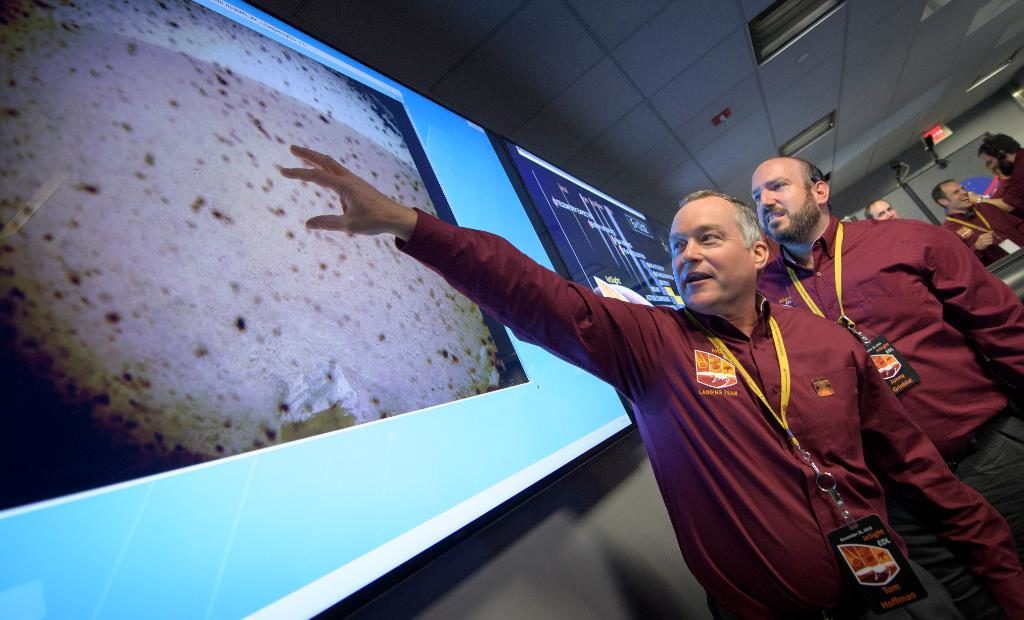 |
|
NASA InSight team rejoices at NASA JPL upon confirmation of successful
landing and receipt of first photo from Mars surface. Credit: NASA |
NASA Administrator Jim
Bridenstine attended the landing events at JPL and spoke and tweeted congratulation
to the entire InSight team, all of the NASA family and space enthusiasts:
the eighth time in human history,” said NASA Administrator Jim Bridenstine.
“InSight will study the interior of Mars, and will teach us valuable science as
we prepare to send astronauts to the Moon and later to Mars. This
accomplishment represents the ingenuity of America and our international
partners and it serves as a testament to the dedication and perseverance of our
team. The best of NASA is yet to come, and it is coming soon.”
Odyssey (MO) and Mars Reconnaissance Orbiter (MRO) Red Planet orbiters are the
primary communications relays for InSight neither could be in place at the
moment of landing to transmit real time data back to anxious engineers on Earth
monitoring the health and status of InSight during the descent.
Thus NASA decided to
send a pair of tiny experimental cubesats to carry out that critical chore- namely
MarCO A and MarCO B.
And they performed marvelously
!! Otherwise we would have had to had more
than 5 hours to learn InSights fate.
Instead it took only
8.1 minutes – the time it takes for radio signals traveling at light speed from
Mars to Earth across a distance of 91 million miles
(146 million kilometers).
Confirmation of InSight’s
successful touchdown and receipt of the terrific 1st photo came via the1st
ever interplanetary cubesats which relayed the critical data in realtime-
namely the pair of briefcase sized Mars Cube One
(MarCO) minisatellites
which traveled to Mars along with but separately from InSight following launch
from Earth on a ULA Atlas V rocket 7 months ago.
Seconds later the two
MarCO’s passed out of range as they continued flying past Mars.
Together they had made
an interplanetary trek of 301 million mile (484 million km) from Earth.
The next critical step is
solar array deployment to provide life giving power to the planned two year long
mission.
Conformation should come in
a few hours.
first mission to Mars surface in 6 years since the Curiosity rover safely touched
down by the skycrane maneuver in 2012 – to begin a minimum 2 year long mission to
study the heart of Mars and elucidate the deep interior of the Red Planet like never
before.
The landing location at Elysium Planitia just
north of the equator is
about 340 miles (550 kilometers) away from Gale Crater – where NASA’s Curiosity
rover landed in 2012.
Engineer’s conducted a final Trajectory
Correction Maneuver known as TCM-6 late Sunday afternoon, Nov 25 to aim InSight
more precisely to the center of the landing ellipse – hoping to shift it about
10 miles west from what TCM-5 accomplished.
The spacecraft is on
course to study Mars deep interior and Marsquakes for the first time in human
history to elucidate how it evolved over 4.5 Billions years. That history has
been erased by natural progression and evolution on and inside Earth including plate
tectonics and erosion of our planet’s crust.
InSight in an international science mission. Loaded aboard are
the two primary science instruments provided by European partners from France
and Germany: The SEIS seismometer and HP3
heat flow measuring instrument.
The SEIS seismometer
instrument is equipped with a trio of incredibly precise seismometers to detect
marsquakes and to detect marsquakes was
provided by the Centre National d’Études Spatiales (CNES) – the French national
space agency equivalent to NASA.
The
other instrument measuring heat flow from the Martian interior is provided by
the German Aerospace Center (DLR) and is named Heat Flow and Physical
Properties Package (HP3).
The HP3 hammering mole will pound about 5 meters
(16 feet) deep into Mars pulling the science heat flow cable tether along to
make heat flow and temperature measurements.
It will pause multiple times along the way down to make detailed
measurements at different depths of heat flow from the planets core.
Other contributions came from Switzerland, Great Brittan and
Poland.
After landing it will take about 2 to 3 months to carefully
lift the two science instruments off the robots deck and deploy them onto Mars
surface using the robotic arm.
InSight is equipped with two cameras. One just below the rover deck is a fisheye. The
other called IDD is a color located at
the terminus of the robotic arm – similar to Phoenix.
The team will use the cameras to carefully and methodically
selected the best spot for the instruments deployments.
The instruments deployments will be deployed to the surface
with a 7 foot long (2 m) robotic arm.
There is also a
weather station aboard to continuously measure Mars local temperatures,
wind speeds and direction and pressures every day 24/7 for the first time on
Mars.
The spacecraft
is based on the design of NASA’s successful Mars lander which touched down safely
back in 2008 which arrived at a slightly faster velocity of 12,500 miles per hour
(5.6 kilometers per second).
Insight is also slightly heavier weighing about
1,340 pounds (608 kilograms) vs. 1,263 pounds (573 kilograms) when it slams
into the atmosphere.
at a slightly higher elevation of “about 4,900 feet (1.5 kilometers) higher
than Phoenix did, so it has less atmosphere to use for deceleration.”
been busy for 7 years to get the spacecraft ready – and the fruits of their labor
was harvested with today’s spectacularly successful landing.
mass of 794 pounds (360 kilograms). It sports a ‘wingspan of 19 feet 8 inches (6 meters) with solar panels
deployed and a width of 5 feet 1 inch (1.56 meters) (lander deck diameter).
InSight
is funded by NASA’s Discovery Program of low cost, focused science missions
along with the science instrument funding contributions from France and
Germany.
Watch for Ken’s
continuing onsite coverage of NASA, SpaceX, ULA, Boeing, Lockheed Martin,
Northrop Grumman and more space and mission reports direct from the Kennedy Space
Center, Cape Canaveral Air Force Station, Florida and Wallops Flight Facility,
Virginia.
Stay tuned here for Ken’s continuing Earth and
Planetary science and human spaceflight news: www.kenkremer.com
–www.spaceupclose.com – twitter @ken_kremer – email: ken at kenkremer.com
Dr.
Kremer is a research scientist, journalist and photographer based in the KSC area.
Ken’s photos are for sale and he is available for lectures and outreach events


